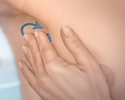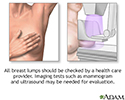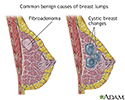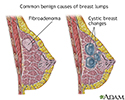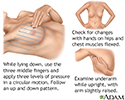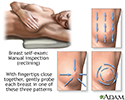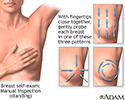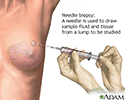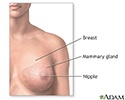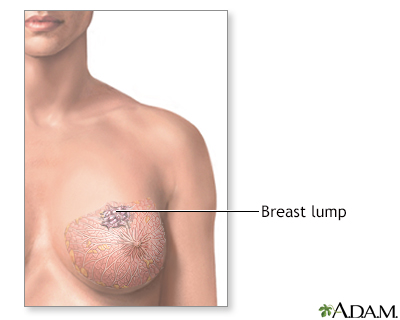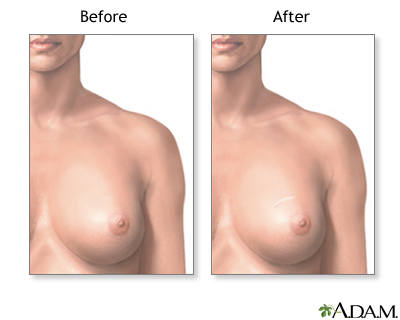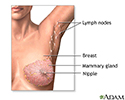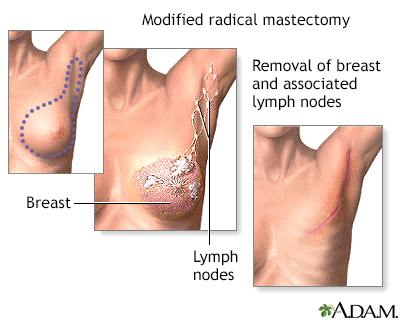Breast lump
Breast mass; Breast nodule; Breast tumorA breast lump is swelling, growth, or mass in the breast. Breast lumps in both men and women raise concern for breast cancer, even though most lumps are not cancer.
Breast self-exam - Animation
Breast self-exam
Animation
Breast lumps
Less than one-fourth of all breast lumps are found to be cancerous, but benign breast disease can be difficult to distinguish from cancer. Consequently, all breast lumps should be checked by a health care professional. Imaging tests such as mammogram and ultrasound may be needed for evaluation.
Breast lumps
illustration
Causes of breast lumps
Most breast lumps are benign (non-cancerous), as in fibroadenoma, a condition that mostly affects women under age 30. Fibrocystic breast changes occur in more than 60% of all women. Fibrocystic breast cysts change in size with the menstrual cycle, whereas a lump from fibroadenoma does not. While most breast lumps are benign, it is important to identify those that are not. See your health care provider if a lump is new, persistent, growing, hard, immobile, or causing skin deformities.
Causes of breast lumps
illustration
Causes of breast lumps
There are many possible causes for lumps in the breast. Most breast lumps are benign, as in fibroadenoma, a condition that affects mostly women under age 30. Breast abscesses are usually incidental to breastfeeding.
Causes of breast lumps
illustration
Breast self-exam
Breast self-exams should always include a visual inspection, with and without a mirror, to note any changes in contour, texture, or color of the breast and nipple. Next, a manual inspection while standing or lying down should be done to note any unusual lumps or thicknesses and check for discharge.
Breast self-exam
illustration
Breast self-exam
Monthly breast self-exams should always include a visual inspection, with and without a mirror, to note any changes in contour or texture, and manual inspection in standing and reclining positions to note any unusual lumps or thicknesses.
Breast self-exam
illustration
Breast self-exam
Monthly breast self-exams should always include a visual inspection, with and without a mirror, to note any changes in contour or texture, and manual inspection in standing and reclining positions to note any unusual lumps or thicknesses.
Breast self-exam
illustration
Breast self-exam
Monthly breast self-exams should always include a visual inspection, with and without a mirror, to note any changes in contour or texture, and manual inspection in standing and reclining positions to note any unusual lumps or thicknesses.
Breast self-exam
illustration
Needle biopsy of the breast
A needle biopsy is performed under local anesthesia. Simple aspirations are performed with a small gauge needle to attempt to draw fluid from lumps that are thought to be cysts. Fine needle biopsy uses a larger needle to make multiple passes through a lump, drawing out tissue and fluid. Withdrawn fluid and tissue is further evaluated to determine if there are cancerous cells present.
Needle biopsy of the breast
illustration
Breast lump removal - series
Presentation
Mastectomy - series
Presentation
Breast lumps
Less than one-fourth of all breast lumps are found to be cancerous, but benign breast disease can be difficult to distinguish from cancer. Consequently, all breast lumps should be checked by a health care professional. Imaging tests such as mammogram and ultrasound may be needed for evaluation.
Breast lumps
illustration
Causes of breast lumps
Most breast lumps are benign (non-cancerous), as in fibroadenoma, a condition that mostly affects women under age 30. Fibrocystic breast changes occur in more than 60% of all women. Fibrocystic breast cysts change in size with the menstrual cycle, whereas a lump from fibroadenoma does not. While most breast lumps are benign, it is important to identify those that are not. See your health care provider if a lump is new, persistent, growing, hard, immobile, or causing skin deformities.
Causes of breast lumps
illustration
Causes of breast lumps
There are many possible causes for lumps in the breast. Most breast lumps are benign, as in fibroadenoma, a condition that affects mostly women under age 30. Breast abscesses are usually incidental to breastfeeding.
Causes of breast lumps
illustration
Breast self-exam
Breast self-exams should always include a visual inspection, with and without a mirror, to note any changes in contour, texture, or color of the breast and nipple. Next, a manual inspection while standing or lying down should be done to note any unusual lumps or thicknesses and check for discharge.
Breast self-exam
illustration
Breast self-exam
Monthly breast self-exams should always include a visual inspection, with and without a mirror, to note any changes in contour or texture, and manual inspection in standing and reclining positions to note any unusual lumps or thicknesses.
Breast self-exam
illustration
Breast self-exam
Monthly breast self-exams should always include a visual inspection, with and without a mirror, to note any changes in contour or texture, and manual inspection in standing and reclining positions to note any unusual lumps or thicknesses.
Breast self-exam
illustration
Breast self-exam
Monthly breast self-exams should always include a visual inspection, with and without a mirror, to note any changes in contour or texture, and manual inspection in standing and reclining positions to note any unusual lumps or thicknesses.
Breast self-exam
illustration
Needle biopsy of the breast
A needle biopsy is performed under local anesthesia. Simple aspirations are performed with a small gauge needle to attempt to draw fluid from lumps that are thought to be cysts. Fine needle biopsy uses a larger needle to make multiple passes through a lump, drawing out tissue and fluid. Withdrawn fluid and tissue is further evaluated to determine if there are cancerous cells present.
Needle biopsy of the breast
illustration
Breast lump removal - series
Presentation
Mastectomy - series
Presentation
Breast lump
Breast mass; Breast nodule; Breast tumorA breast lump is swelling, growth, or mass in the breast. Breast lumps in both men and women raise concern for breast cancer, even though most lumps are not cancer.
Breast lump
Breast mass; Breast nodule; Breast tumorA breast lump is swelling, growth, or mass in the breast. Breast lumps in both men and women raise concern for breast cancer, even though most lumps are not cancer.
Review Date: 11/6/2021
Reviewed By: Debra G. Wechter, MD, FACS, General Surgery Practice Specializing in Breast Cancer, Virginia Mason Medical Center, Seattle, WA. Also reviewed by David Zieve, MD, MHA, Medical Director, Brenda Conaway, Editorial Director, and the A.D.A.M. Editorial team.

